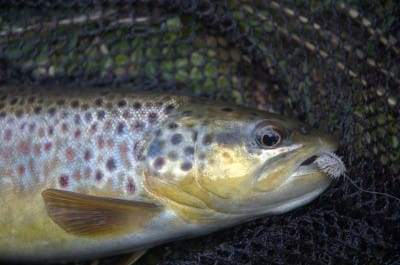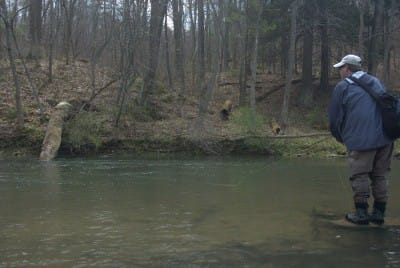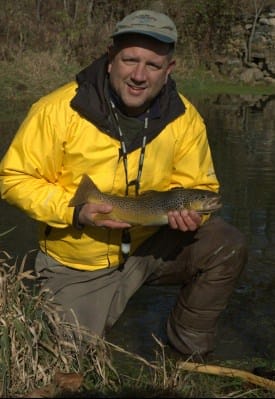
“You gonna set the hook on those fish, Beau?” Eric Stroup asked me sternly.
Stroup had asked me to fish Spring Creek in central Pennsylvania, a stream famous for its brown trout. We’d already changed locations twice, going farther upstream each time, and still the browns weren’t eager to cooperate.
“What fish?” I asked incredulously.
“Well, for starters,” Stroup replied patiently, “the one that’s hit your line at least twice since we’ve been fishing here the past few minutes.”
We’d cast a few dries downstream and a small BWO hatch began to lift off the water. Unfortunately, I’d been unsuccessful at my dry fly attempts but had managed to sting one pretty well. Stroup had suggested we try nymphing, and I’d been casting along a likely looking bank with a nice set of riffles. I saw a tiny twitch with my leader and set the hook-and came up with nothing for my trouble. Again with the hits and again with the goose eggs.
Fishing for brown trout in the fall, even with the help of a guide as adept as Eric Stroup, can be tough, but it’s also rewarding. Though browns are not generally known for vicious strikes during the day, fall weather patterns are more to their liking. Like most trout, browns start out feasting on tiny aquatic insects. Eventually they move on to small fish as they grow larger and more mature and their caloric intake increases. Like teenage boys with their heads stuck perpetually in the refrigerator, growing brown trout yearn for the filling meal. These guys really put on the feedbag as winter approaches, so targeting them in the fall might earn you the largest catch of the season.
I approach fall browns in one of three ways. First, I cast dry flies. They’re fun, of course, because I get to watch the take, when there is a take. But as brown trout are notoriously shy, one must try something new when dry flies aren’t working.
Next, I try nymphing, which is what Stroup and I were doing on Spring Creek. Nymphing can bring home the bacon, certainly but you must control your line. Keep as much slack out of the line as possible or you’ll miss subtle strikes. Trout can sip a fly in and then spit it out again in mere seconds, so you’ll need a relatively tight line to be able to feel and respond to the slightest twitch in time.

Finally, I reach for the large streamers. I’ll admit that chucking big streamers along shorelines and good structure like rocks and logs requires a lot of patience because you may go for long stretches without a nibble. What’s the upside? Browns that hit streamers are generally much older and therefore much larger. The hook-jawed browns you see on the cover of fly fishing magazines are almost always caught on streamers.
Fall fishing tackle begins fairly close to home: Being comfortable means that you’ll stay long enough on the water to discover what the fish are hitting. So wear warm clothes, breathable waders, and warm, wicking socks. Cold feet have probably ruined more fall trout fishing trips than tight-lipped trout ever have. Take along a good wading staff to prevent the unintended swim. Should you take a spill anyway, you’ll wish that you had packed a spare set of clothes in the car. Go ahead and pack a bag now so that you don’t forget later. I’ll wait.
Aside from your personal outfit, you’ll want to give some thought to your gear. Most anglers use 4- to 6-weight rods in the 8 ½- to 9-foot range and floating fly lines, though sink-tip lines will work if the water is deep or has significant current. Patterns can range from standards like Barr’s Copper Johns and Coburn’s Cress Bugs in sizes No. 16-20 to large streamers like Clouser Minnows or standard crayfish patterns that can easily reach No. 2. Finally, effective fall surface patterns include terrestrials like hoppers and crickets in sizes No. 6-10, as well as old reliables like Blue Wing Olives and stimulators in No. 14-18.

Load up that fly box with a variety of patterns so that you’re prepared no matter what your quarry is after that day. After all, if those wily fall browns skunk you now, you’ll have to explain to your spouse that you packed an overnight case for a day trip and spent nearly $10 per foot on specialty socks-and landed nothing to show for it.
Visit www.sprucecreekflyco.com for more information on Spring Creek in central Pennsylvania.
Beau Beasley is a career captain with Fairfax Country Fire and Rescue Department and a member of Local 2068. His second book, Fly Fishing the Mid-Atlantic: A No Nonsense Guide to Top Waters, will be released January 2011. To order your autographed copy, please visit www.beaubeasley.com.







